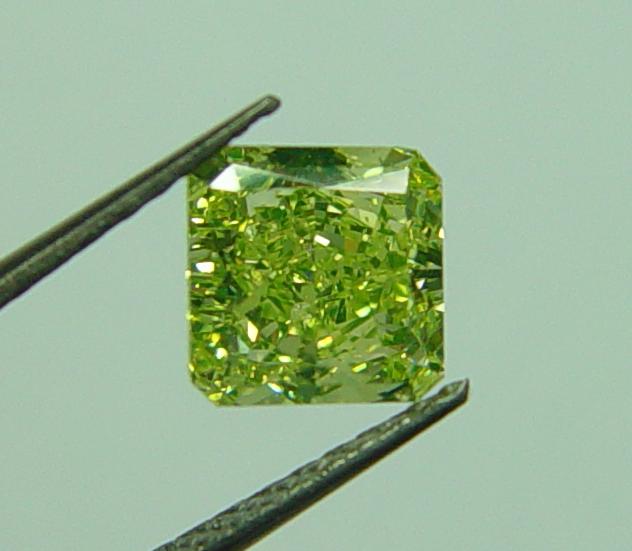A Rare and Unique Natural Treasure
A green diamond is a diamond that exhibits a natural green body colour, making it one of the rarest and most sought-after coloured diamonds in the world. For a diamond to be classified as a true green diamond, green must be the dominant hue, although it may have secondary modifying tones of yellow, blue, or grey.
These remarkable diamonds owe their distinctive green hue to exposure to natural radiation deep within the Earth’s crust over millions of years. The radiation interacts with the diamond’s atomic structure, creating unique structural defects that result in its green coloration. Because of the highly specific and rare conditions required for their formation, natural green diamonds are exceptionally rare and valuable.
Formation of Natural Green Diamonds
Unlike most coloured diamonds, which owe their colour to trace elements (such as boron in blue diamonds or nitrogen in yellow diamonds), green diamonds derive their colour from natural irradiation.
How it Happens:
Natural Radiation Exposure: Over millions of years, the diamond is exposed to radioactive minerals such as uranium or thorium in the Earth’s crust.
Structural Alterations: The radiation disrupts the arrangement of carbon atoms in the diamond’s crystal lattice, creating a “radiation-induced colour centre.”
Absorption of Light: These defects allow the diamond to absorb red and yellow light, making the diamond appear green to the human eye.
Key Fact: The green colour usually forms on the surface of the rough diamond, which means that careful cutting is required to preserve the colour in the final polished gem.
Shades & Intensity of Green Diamonds
Like all fancy-coloured diamonds, green diamonds are graded based on hue, tone, and saturation. The most valuable green diamonds have a pure green hue with strong saturation. However, many natural green diamonds exhibit secondary modifying tones that affect their final colour.
Green Diamond Colour Classifications:
Colour Name Description Common Secondary Hues
Fancy Light Green Soft, pastel green colour Yellow, Grey
Fancy Green True green with medium saturation Yellow, Blue
Fancy Intense Green Vibrant, rich green hue Blue, Yellow
Fancy Vivid Green Deep, highly saturated green Minimal or No Modifying Tones
Fancy Deep Green Darker green with strong depth Grey, Yellow
The rarest and most valuable green diamonds are those with a strong, pure green hue and minimal secondary modifiers.
Famous Green Diamonds
Due to their rarity, natural green diamonds have become legendary in the world of gemstones. Some of the most famous examples include:
The Dresden Green Diamond (41.00 ct)
One of the most famous and largest natural green diamonds in existence.
Weighing 41.00 carats, it exhibits a pure green colour with exceptional clarity.
Believed to have originated in India, it is now housed in Germany’s Green Vault museum.
The Aurora Green Diamond (5.03 ct)
The largest Fancy Vivid Green diamond ever auctioned.
Sold for $16.8 million at Christie’s in 2016.
The Ocean Dream Diamond (5.51 ct)
A unique blue-green diamond with a distinctive Fancy Deep Blue-Green colour.
Exhibits a combination of radiation exposure and boron content.
The Chopard Green Diamond (10.02 ct)
A Fancy Intense Green diamond set in a ring by Chopard.
One of the most valuable green diamonds in the world.
How Are Green Diamonds Graded?
Green diamonds are graded based on the 4Cs (Carat, Colour, Clarity, and Cut), with special emphasis on colour intensity.
Hue: The primary colour must be green, though modifying hues like yellow, blue, or grey may be present.
Tone: Determines how light or dark the green appears.
Saturation: The strength or intensity of the green hue—more saturated stones are more valuable.
Laboratories like the GIA (Gemological Institute of America) and DCLA (Diamond Certification Laboratory of Australia) provide certificates to verify a green diamond’s natural origin.
Treated vs. Natural Green Diamonds
Because natural green diamonds are incredibly rare, some diamonds undergo treatments to enhance or artificially create a green hue. These treatments include:
Radiation Treatment – Exposing diamonds to artificial radiation to mimic natural colouration.
HPHT (High Pressure, High Temperature) Processing – Alters the internal structure to change colour.
Coating – Applying a thin layer of green material to the diamond’s surface.
Key Buyer’s Tip: Always verify that a green diamond’s colour is natural by requesting a grading report from an independent, recognised gemological laboratory (such as DCLA or GIA).
Are Green Diamonds a Good Investment?
Extreme Rarity – Natural green diamonds are among the rarest coloured diamonds, making them highly desirable.
High Market Demand – Prices for Fancy Vivid Green diamonds have consistently increased over time.
Auction Record Breakers – Green diamonds regularly fetch millions at auctions.
The most valuable green diamonds are Fancy Intense or Fancy Vivid Green with minimal secondary hues and strong saturation.

